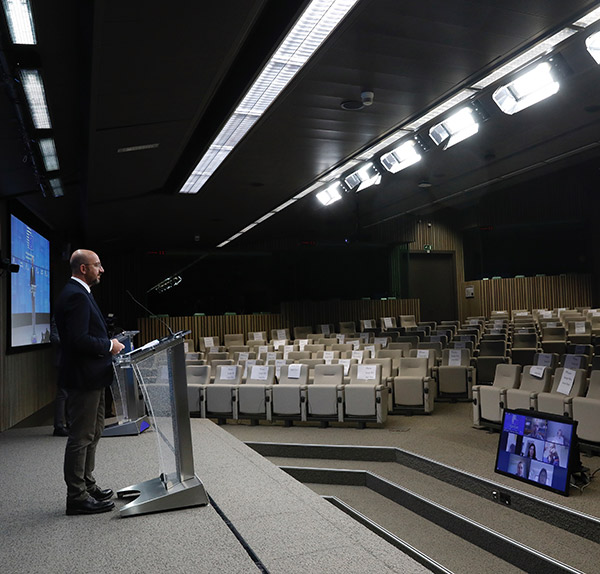Virtual decision-making as the new coronavirus reality for EU leaders

date: 06/05/2020
European summits and ministerial meetings in Brussels
In mid-March – due to the corona crisis – the overwhelming majority of the nearly 3000 staff in Brussels who support the Council and European Council had to start working from home to limit the spread of the virus. From the very beginning, the objectives have been to keep staff safe whilst allowing the Council to carry out its vital functions, including coordinating the EU's response to the crisis. For the last two months, advisors have kept on drafting documents for ministerial meetings whilst having their children playing on the carpet in the same room and their significant other also teleworking from home.
Heads of state or government and national ministers usually travel to Brussels and meet in the iconic, multi-colored meeting room of the Europa building. Warm hugs, handshakes and a kiss on the cheek here and there serve as a welcome. These meetings go on until late in the night. Debates and search for compromise are accompanied by the discrete presence of staff and the hissing of bottles of mineral water being opened.
Between 60 and 70 interpreters work at full speed in their booths.
That was before Corona.
Nobody comes, everyone participates
Today, nobody attends but everyone participates. The attendees connect from all over Europe. German Chancellor Merkel, French President Macron, Finland's Prime Minister Sanna Marin and all the other EU leaders now meet virtually. Charles Michel, President of the European Council, hosts them virtually on flat screens, in a newly rearranged room and an almost empty building. Council staff work in the background to prepare meetings and ensure everything runs smoothly. Given their technical complexity, virtual meetings need to be very well prepared and facilitated.
"Hello, can you hear me?", is often the first question asked by EU leaders or ministers during virtual meetings. Despite the odd technical hitch, everything works well. As ministers and delegates cannot come to Brussels at the moment for obvious reasons, the number of meetings has been reduced drastically, with only the most important maintained. The interpretation service is limited, but new technologies are gradually being introduced to provide a more comprehensive service.
The challenge of videoconferences
The initial phase was challenging. We are not talking about a simple Skype chat. In order to meet the high demand for meetings and ensure data security, an expanded infrastructure had to be created. To make this transition from physical to virtual possible, IT experts have worked hard to implement and enhance this capability to respond to new needs and meet high security standards. A range of services are involved in making this happen: IT, the audiovisual service, the technical support team and meetings and facility management.
Not everything can become digital
Still, the EU cannot be run in a purely digital world. Legal acts cannot be formally adopted during a videoconference. The Council's rules require the physical presence of decision makers or, alternatively, that decisions be taken in writing. Videoconferences are therefore not official Council meetings as such. But they are essential for the preparation of Council decisions which can be taken in writing.
On 5 May 2020 employment and social affairs ministers 'came together' remotely and debated exit and recovery measures. The next European summit is scheduled to be held on 18-19 June. Let's see whether this one will take place in the real world. It would be reassuring to see EU leaders shaking hands and hugging again.
